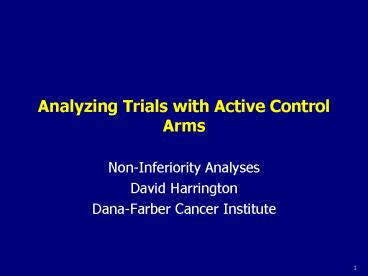Analyzing Trials with Active Control Arms - PowerPoint PPT Presentation
1 / 14
Title:
Analyzing Trials with Active Control Arms
Description:
Dana-Farber Cancer Institute. Disclaimers... No financial support from sponsor. Expenses paid by ... Will not discuss in detail or evaluate the analyses in ... – PowerPoint PPT presentation
Number of Views:40
Avg rating:3.0/5.0
Title: Analyzing Trials with Active Control Arms
1
Analyzing Trials with Active Control Arms
- Non-Inferiority Analyses
- David Harrington
- Dana-Farber Cancer Institute
2
Disclaimers
- No financial support from sponsor
- Expenses paid by FDA as a member of ODAC
- Will not discuss in detail or evaluate the
analyses in the application, but will use some
data for context
3
Trials in Application
Trial Number of Participants Population Postmenopausal women Primary Endpoint
STAR 19,747 High risk of breast cancer Invasive Breast Ca
RUTH 10,101 With or at risk of coronary events Coronary events, inv. Breast Ca
MORE 7,705 With osteoporosis Vertebral fracture
CORE 4,011 With osteoporosis Invasive Breast Ca
4
Main Statistical Issue in Analysis of STAR
- Application contains non-inferiority (NI)
analysis of Raloxifene vs Tamoxifen in STAR
trial. - Primary endpoint is invasive breast cancer
- Raloxifene is test agent
- Tamoxifen is an active control
- Analysis of active control trials uses
information outside of current trial to infer
effect of a study drug (raloxifene) vs placebo in
absence of a direct comparison - See Rothmann et al. (2003), Temple Ellenberg
(2000), many others - What questions should be asked about NI analysis?
5
Tamoxifen vs Placebo NSABP P1 Trial Subset of
7,998 Women ? 50 years old
Favors Tamoxifen
Favors placebo
RR 0.47 (0.33 - 0.66)
Interpretation T reduces the rate of invasive
breast cancer incidence on placebo by 53
(confidence interval 34 to 67)
1.4
1.2
1.0
0.8
0.6
0.4
1.6
Relative Risk for Invasive Br Ca Tamoxifen /
Placebo
6
Tamoxifen vs Placebo NSABP P1 Trial Subset of
Women ? 50 years old
RR 2.12 (1.52 - 3.03)
Interpretation P increases the rate of invasive
breast cancer incidence compared to Tam by 112
(confidence interval 52 to 303)
Relative Risk for Invasive Br Ca Placebo /
Tamoxifen
7
Potential Designs for Evaluating Raloxifene
Raloxifene
R A N D O M I Z E
STAR designed as superiority trial R vs T
85 power if RR (R/T) lt 0.67 95 power if RR
(R/T) gt 1.56
Tamoxifen
Placebo
Observed RR 1.02 Application has
non-inferiority analysis of STAR
8
Tamoxifen vs Placebo NSABP P1 Trial Subset of
Women ? 50 years old
Favors Tamoxifen
Favors Placebo
RR 2.12 (1.52 - 3.03)
NI margin 50 of Active control effect retained.
56 increased risk on P
RR 1.56
1.84
1.28
2.2
2.4
2.6
2.0
1.8
1.6
1.4
1.2
1.0
0.8
0.6
Relative Risk for Invasive Br Ca Placebo /
Tamoxifen
9
Possible Outcomes of Active Control Trials
Favors Active Control
Favors Test Tx
NI margin 50 of Active control effect retained.
56 increased risk on P
Placebo vs Active Control RR 2.12, with C.I.
Relative Risk Test Treatment / Active Control
10
Goal of Active Control (NI) Analysis
- How would test treatment compare to placebo, had
placebo been present in the trial? - Estimate effect of T compared to active control
(C) in current trial (T vs C) - Use data from previous trials to estimate effect
of P vs C, along with a margin of error for that
effect - Combine these estimates to evaluate putative
effect of T vs P - Sometimes done by estimating the range of percent
retention of the P vs C effect consistent with
data (confidence interval for NI margin) - If T has fewer side effects than active control,
T may be useful even if not as effective as C
11
Most important issue when evaluating NI
analysesextrapolation
- NI analyses are based on one or more previous
trials and a current trial and use information
gained in potentially different settings. - More careful labeling is helpful
- Current trial T test treatment, C2 active
control, P a putative (unobserved) Placebo - Previous trial(s) C1 the same control, P1 the
placebo
12
Assumptions in NI Analysis
- T vs C2 well conducted.
- P vs C2 P1 vs C1 if placebo had been present
in current trial (assay sensitivity) - P1 vs C1 effect has not changed since prior
trials, or any change can be modeled - Uncertainty in P1 vs C1 effect can be estimated
- Both within and between trial variability
relevant - P1 vs C1 sometimes estimated from meta-analysis
of prior trials. - Clinically relevant non-inferiority margin was
specified before analysis - Assumptions all used in inference
13
Some Questions to ask about NI analyses
- Is the claim of NI supported by a biological
rationale? - Might the effect of Active Control (vs placebo)
have been different in current trial? - Changes in administration of agent
- Differences in populations using the drug or in
endpoint determination - Has long term follow-up changed the thinking of
the value of the active control? - Does the analysis use the best available
historical data on active control to estimate
both treatment effects and uncertainty in the
estimate? - Justification for omitted trials
14
Questions
- Is an estimated NI margin clinically relevant?
Was it specified in advance of the analysis? - Is a reduced therapeutic effect for the test
agent balanced by other benefits? - What is the margin of error (confidence interval)
in the estimate of possible loss of efficacy? - Are results consistent across related endpoints?
- As in all trials, treatment effects measured in
NI analyses are estimates of population effects,
not predictions of efficacy for individuals - Is there a clear signal to the treating clinician
on when to use the active control vs the new
treatment?































